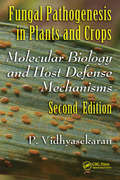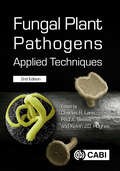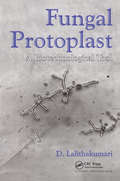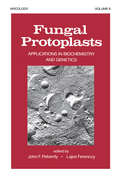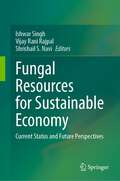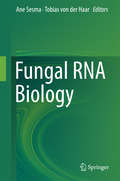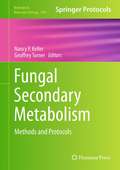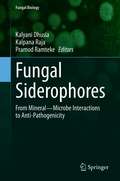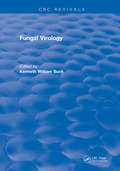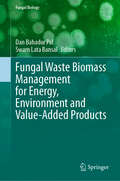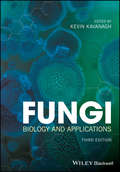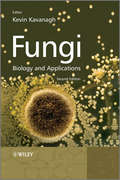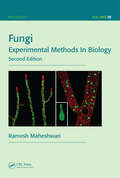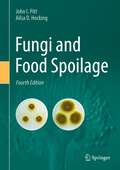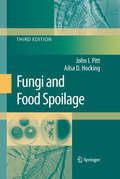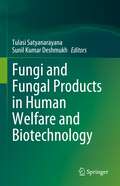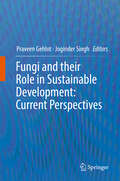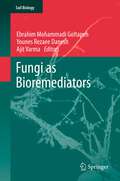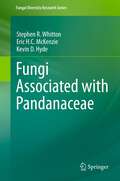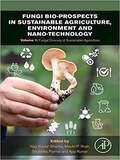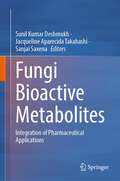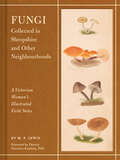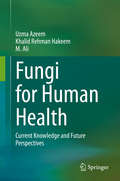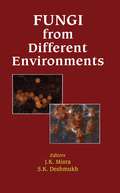- Table View
- List View
Fungal Pathogenesis in Plants and Crops: Molecular Biology and Host Defense Mechanisms, Second Edition (Books in Soils, Plants, and the Environment)
by P. VidhyasekaranDramatic progress in molecular biology and genetic engineering has recently produced an unparalleled wealth of information on the mechanisms of plant and pathogen interactions at the cellular and molecular levels. Completely revised and expanded, Fungal Pathogenesis in Plants and Crops: Molecular Biology and Host Defense Mechanisms, Second Edition
Fungal Plant Pathogens: Applied Techniques
by Kinda Alraiss Rachel Barker Victoria Barton Lucy Carson-Taylor David Cooke Ashleigh Elliot David Galsworthy Steve Hendry Anthony Kermode Paul Kirk Michael Long Aiga Ozolina Ana Pérez-Sierra Belinda Phillipson Matthew J Ryan David Smith Christopher Thornton Jenny Tomlinson Joan WebberThis substantially updated edition now in full colour provides key techniques used when working with fungal and fungal-like plant pathogens. As a practical manual it also deals with disease recognition, detection and identification of fungi, plus methods to characterise and curate fungi and handle them under quarantine and quality assurance systems. Furthermore, this new edition includes significant updates with respect to: - Greater awareness and concern internationally about plant health and biosecurity. - Molecular biology - next generation sequencing and in-field detection. - Improved opportunities for surveillance and detection in diverse substrates. - Changes in taxonomy and reference to current fungal plant pathogens. - New chapters on tree health, and public awareness, outreach and communications. Fungal Plant Pathogens: Applied Techniques, 2nd edition provides a valuable guide to investigating fungal plant diseases and interpreting laboratory findings for postgraduate and advanced undergraduate students, extension plant pathologists, consultants and advisers in agriculture, forestry and horticulture, and the food supply chain.
Fungal Protoplast: A Biotechnological Tool
by D LalithakumariBetter validation of indigenous domestic animal genetic resources is becoming more important with regard to the potential of livestock for poverty alleviation and income generation. To improve indigenous breeds for sustainable income and employment generation, the methods to be employed are the same as developed in systematic breeding programs, be it for cross-breeding or selective breeding within a specific breed. This book systematically introduces the reader to the breed improvement theory and illustrates the theory with practical examples and case studies. The book is addressed to animal science teachers, to undergraduate and postgraduate students as well as to decision makers in the state and central livestock departments.
Fungal Protoplasts: Applications in Biochemistry and Genetics
by John F. PeberdyUntil now, information on fungal protoplasts has been scattered throughout various sources. With authoritative reviews of protoplast isolation and applications in fungal biology research, Fungal Protoplasts: Applications in Biochemistry and Genetics is the first volume devoted to a major area in experimental mycology-fungal protoplasts.Written by 18 pioneering experts, this unmatched, illustrated reference presents well-established knowledge of protoplast research as well as newer ideas and methods. The book encompasses advances in protoplast isolation techniques and methodology, uses of protoplasts in physiological, biochemical, and genetic studies, and developments in protoplast fusion that form the basis for transformation and gene cloning experiments, including applications in industrial biotechnology. This fact-filled book also features end-of-chapter bibliographies for further research.
Fungal Resources for Sustainable Economy: Current Status and Future Perspectives
by Ishwar Singh Vijay Rani Rajpal Shrishail S. NaviThis edited book provides a comprehensive account of the new developments in various facets of fungal biology related to the impact and application of fungi on the sustainable economy. The book consists of 24 chapters distributed under five sections written by active researchers and academicians from India and abroad. The five sections of the book are- 1. Fungi in Sustainable Economy, 2. Fungal Resources: Current and Potential Industrial Applications, 3. Fungal Resources: Current and Potential Agricultural Applications, 4. Fungi and their Secondary metabolites: Implications and 5. Fungi: Burden to health and Indoor Environment.The book explores the utility of fungi as food, enzymes, organic compounds, nutraceuticals, pharmaceuticals and agricultural productivity promoter. It also highlights the negative fungal impacts on food production, health and environment. The book is useful to postgraduate students studying mycology, plant pathology, crop protection, agricultural sciences, and plant sciences. In addition, scientists involved in biological and agricultural research, crop management, and various industries that manufacture or utilize fungal products on a small to large scale shall also find the book helpful.
Fungal RNA Biology
by Ane Sesma Tobias HaarThis book presents an overview of the RNA networks controlling gene expression in fungi highlighting the remaining questions and future challenges in this area. It covers several aspects of the RNA-mediated mechanisms that regulate gene expression in model yeasts and filamentous fungi, organisms of great importance for industry, medicine and agriculture. It is estimated that there are more than one million fungal species on the Earth. Despite their diversity (saprophytic, parasitic and mutualistic), fungi share common features distinctive from plants and animals and have been grouped taxonomically as an independent eukaryotic kingdom. In this book, 15 chapters written by experts in their fields cover the RNA-dependent processes that take place in a fungal cell ranging from formation of coding and non-coding RNAs to mRNA translation, ribosomal RNA biogenesis, gene silencing, RNA editing and epigenetic regulation.
Fungal Secondary Metabolism
by Geoffrey Turner Nancy P. KellerFilamentous fungi have long been known for their ability to produce an enormous range of unusual chemical compounds known as secondary metabolites, many of which have potentially useful antibiotic or pharmacological properties. Recent focus on fungal genomics coupled with advances in detection and molecular manipulation techniques has galvanized a revitalization of this field. Fungal Secondary Metabolism: Methods and Protocols is aimed at providing the key methodologies currently in use and necessary for accessing and exploiting the natural product information provided by the genomes of this large and varied kingdom. Written by active researchers in the field, the chapters deal with all the steps necessary, from optimization of fungal culture conditions for metabolite production, through rapid genome sequencing and bioinformatics, and genetic manipulations for functional analysis, to detection and testing of metabolites. In addition, chapters on basic science address approaches to the genetic regulation, protein biochemistry, and cellular localization of the biosynthetic pathways. Written in the highly successful Methods in Molecular BiologyTM series format, chapters include introductions to their respective topics, lists of the necessary materials and reagents, step-by-step, readily reproducible laboratory protocols, and tips on troubleshooting and avoiding known pitfalls. Practical and hands-on, Fungal Secondary Metabolism: Methods and Protocols encourages new investigators to enter the field and expands upon the expertise and range of skills of those already researching fungal natural products.
Fungal Siderophores: From Mineral―Microbe Interactions to Anti-Pathogenicity (Fungal Biology)
by Kalyani Dhusia Kalpana Raja Pramod RamtekeIn the past few decades, it has been realized through research that fungal siderophores epitomize the uptake of iron as well as other essential elements like zinc, magnesium, copper, nickel and arsenic. Understanding the chemical structures of different fungal siderophores and the membrane receptors involved in uptake of mineral ions has opened new areas for research. In this edited volume, recent research is presented on fungal siderophores in one comprehensive volume to provide researchers a strong base for future research. Siderophores are the low molecular weight, high affinity iron-chelating compounds produced by bacteria and fungi. They are responsible for transporting iron across the cell membrane. Fungi produce a range of hydroxamate siderophores involved in the uptake of essential elements in almost all microorganisms and plants. In recent years, siderophores have been used in molecular imaging applications to visualize and understand cellular functions, which thus provide an opportunity to identify new drug targets. Therefore, knowledge of fungal siderophores has become vital in current research. Siderophores have received much attention in recent years because of their potential roles and applications in various research areas. Their significance in these applications is because siderophores have the ability to bind a variety of metals in addition to iron, and they have a wide range of chemical structures and specific properties. For instance, siderophores function as biocontrols, biosensors, and bioremediation and chelation agents, in addition to their important role in weathering soil minerals and enhancing plant growth. This book focuses on siderophores with the following significant points. It discusses leading, state-of-the-art research in all possible areas on fungal siderophores. The contributors are well-known and recognized authorities in the field of fungal siderophores. It discusses a projection of practical applications of fungal siderophores in various domains. This is the first book exclusively on fungal siderophores. In this comprehensive, edited volume, we show leading research on fungal siderophores and provide the most recent knowledge of researchers' work on siderophores. This book presents in-depth knowledge on siderophores to researchers working in areas of health sciences, microbiology, plant sciences, biotechnology, and bioinformatics.
Fungal Virology
by Kenneth William BuckSince their discovery 25 years ago, fungal viruses have created a new field of study in mycology and virology. The purpose of this book is not only to serve as a useful reference work but also to provide reviews of the important advances which have taken place since the last books on fungal viruses appeared. An introductory chapter gives a critical overview of fungal virology in the context of virology as a whole and of recent developments in molecular biology. Specialist chapters follow, all written by experts who are currently active in fungal virus research and cover ongoing research areas.
Fungal Waste Biomass Management for Energy, Environment and Value-Added Products (Fungal Biology)
by Dan Bahadur Pal Swarn Lata BansalBioconversion of waste is a natural process aiding in the recovery of resources and biotechnology-facilitated natural recycling processes. Biotechnological treatments to food processing wastes found in large quantities can produce useful end products, such as microbial biomass protein, while wastes are also purified during the process. Fungi as microorganism and as fungal biomass have been used for many applications such as enzyme production for biomedical, biorefinery, and other industries. Additionally, environmental pollution is a crucial problem for the entire world, and it is growing continuously. Continuous growth of pollution is resulting harmful changes like global warming and pollution of air, water, and soil. These changes are directly associated with various activities like uncontrolled agricultural practices, deforestation, urbanization, accumulation of huge amounts of agricultural and food waste, improper dumping of naturally occurred waste and forest residues, etc. Therefore, proper utilization of these wastes may be a better solution for this problem. Fungal-based biomass materials are good sources of carbohydrates, oil & fats, cellulosic content, and other useful chemical components which can be converted into value-added products for production of clean energy, bioenergy, bio-adsorbents, and useful chemicals. This book provides information, processes, and ideas for the conversion of waste into useful and consumable enzymes through biological approaches. Within the last few years, researchers have found that food and agricultural waste biomass have the potential to produce value-added products. Technological information for the production of nutraceuticals and organic acids from the agro-waste are also covered in this book.
Fungi: Applications and Management Strategies (Progress in Mycological Research #3)
by Sunil K. Deshmukh J. K. Misra Jalpa P. Tewari Tamas PappThe book deals with the application of fungi and the strategic management of some plant pathogens. It covers fungal bioactive metabolites, with emphasis on those secondary metabolites that are produced by various endophytes, their pharmaceutical and agricultural uses, regulation of the metabolites, mycotoxins, nutritional value of mushrooms, prospecting of thermophilic and wood-rotting fungi, and fungi as myconano factories. Strategies for the management of some plant pathogenic fungi of rice and soybean have also been dealt with. Updated information for all these aspects has been presented and discussed in different chapters.
Fungi: Biology and Applications
by Kevin KavanaghThis newly updated edition covers a wide range of topics relevant to fungal biology, appealing to academia and industry Fungi are extremely important microorganisms in relation to human and animal wellbeing, the environment, and in industry. The latest edition of the highly successful Fungi: Biology and Applications teaches the basic information required to understand the place of fungi in the world while adding three new chapters that take the study of fungi to the next level. Due to the number of recent developments in fungal biology, expert author Kevin Kavanagh found it necessary to not only update the book as a whole, but to also provide new chapters covering Fungi as Food, Fungi and the Immune Response, and Fungi in the Environment. Proteomics and genomics are revolutionizing our understanding of fungi and their interaction with the environment and/or the host. Antifungal drug resistance is emerging as a major problem in the treatment of fungal infections. New fungal pathogens of plants are emerging as problems in temperate parts of the world due to the effect of climate change. Fungi: Biology and Applications, Third Edition offers in-depth chapter coverage of these new developments and more—ultimately exposing readers to a wider range of topics than any other existing book on the subject. Includes three new chapters, which widen the scope of fungi biology for readers Takes account of recent developments in a wide range of areas including proteomics and genomics, antifungal drug resistance, medical mycology, physiology, genetics, and plant pathology Provides extra reading at the end of each chapter to facilitate the learning process Fungi: Biology and Applications is designed for undergraduate students, researchers, and those working with fungi for the first time (postgraduates, industrial scientists).
Fungi
by Kevin KavanaghFungi: Biology and Applications, Second Edition provides a comprehensive treatment of fungi, covering biochemistry, genetics and the medical and economic significance of these organisms at introductory level. With no prior knowledge of the subject assumed, the opening chapters offer a broad overview of the basics of fungal biology, in particular the physiology and genetics of fungi and also a new chapter on the application of genomics to fungi. Later chapters move on to include more detailed coverage of topics such as antibiotic and chemical commodities from fungi, new chapters on biotechnological use of fungal enzymes and fungal proteomics, and fungal diseases of humans, antifungal agents for use in human therapy and fungal pathogens of plants.
Fungi: Experimental Methods In Biology, Second Edition (Mycology)
by Ramesh MaheshwariFungi are now at the forefront of research on mechanisms in gene silencing, biological rhythm, mating processes, biogenesis of intracellular organelles, adaptations to hostile habitats, structure of natural populations, and speciation. Because of their small genomes, fungi are being used in "systems biology" to understand the connections between ge
Fungi and Food Spoilage
by John I. Pitt Ailsa D. HockingThe first three editions of Fungi and Food Spoilage established, then consolidated, a reputation as the leading book on foodborne fungi. It details media and methods for isolation and identification, descriptions of species, and information on their physiology, ecology and mycotoxin formation. It is an invaluable reference for food microbiologists investigating fungal food spoilage problems, both in field crops and processed foods, and the likelihood of mycotoxin production in either.The Fourth Edition incorporates major differences from the Third: multiple changes in nomenclature due to changes in the International Code of Nomenclature for algae, fungi and plants; many taxonomic changes due to improvements in, and more widespread application of, molecular methods in taxonomy; the introduction of colour colony photographs where appropriate; and a new chapter on mycotoxins.The introductory chapters of the book deal with the ecology of food spoilage, and provide an overview of how food processing, packaging and storage parameters influence fungal growth. A subsequent chapter overviews the fundamentals of naming and classifying fungi. Morphological methods and media suitable for low cost and effective isolation, enumeration and identification of foodborne fungi are provided, together with many more specialised media and techniques. The major part of the book provides keys, descriptions and illustrations of all yeasts and filamentous fungi commonly encountered in foods. Other known characteristics of the species, including physiology and ecology are included. Chapters on the types and species of fungi likely to be found in fresh, harvested and variously processed foods are followed by a new chapter on mycotoxins, both major and minor, their sources, both fungal and food, and their implications for human health.The broad and practical nature of the coverage will appeal to microbiologists, mycologists and biotechnologists in the food industry, as well scientists in academic, research and public health institutions.Drs Pitt and Hocking worked for CSIRO Food for more than 100 years combined. Both are now retired from CSIRO: Dr Pitt continues to work part time with Microbial Screening Technologies, a biodiscovery company.
Fungi and Food Spoilage
by John I. Pitt Ailsa D. HockingThis is the third edition of the definitive work on fungi in foods covering identification, isolation, enumeration, taxonomy, physiology and mycotoxin formation. High quality halftones provide a book of great value to food microbiologists, mycologists, food scientists and technologists and all those involved in food quality and safety.
Fungi and Fungal Products in Human Welfare and Biotechnology
by Tulasi Satyanarayana Sunil Kumar DeshmukhThis book presents various biotechnological applications of the fungal systems in pharmaceuticals, nutraceuticals, textile industry, bioremediation, biofuel, and the production of biomolecules. It discusses the important role of fungal secondary metabolites in human welfare and nutrition. It explores fungi as the vital sources of novel substances with antidiabetic, antibiotic as well as prebiotic properties. The book further describes the natural and unique ability of fungi to biodegrade macro- and microplastics by using them as a source of carbon and energy. Notably, it presents the properties and applications of bioactive fungal polysaccharides and discusses the latest developments in utilizing these biopolymers in human nutrition. In addition, the book examines the production of biodegradable and sustainable natural colorants from fungal sources. This book is a valuable source for mycologists, biotechnologists, and microbiologists for understanding the important role of fungi in biotechnology.
Fungi and their Role in Sustainable Development: Current Perspectives
by Joginder Singh Praveen GehlotThis book illustrates the multiple roles of fungi in everyday life. Fungi are the large group of organisms with tremendous diversity and economic importance. Their ability to produce commercially efficient useful products makes them the vulnerable sustainable tool for the future generation. This book describes a systems approach and provides a means to share the latest developments and advances about the benefits of fungi including their wide application, traditional uses, modern practices, along with designing of strategies to harness their potential. The chapters are organized with data, providing information related to different sustainable aspects of fungi in agriculture, its cultivation and conservation strategies, industrial and environmental utilization, advanced bioconversion technologies and modern biotechnological interventions. Updated information and current opinion related to its application for sustainable agriculture, environment, and industries as futuristic tools have been presented and discussed in different chapters. The book also elucidates a comprehensive yet a representative description of the challenges associated with the sustained application of fungi to achieve the goals of sustainability.
Fungi as Bioremediators
by Ajit Varma Ebrahim Mohammadi Goltapeh Younes Rezaee DaneshBiological remediation methods have been successfully used to treat polluted soils. While bacteria have produced good results in bioremediation for quite some time now, the use of fungi to decontaminate soils has only recently been established. This volume of Soil Biology discusses the potentials of filamentous fungi in bioremediation. Fungi suitable for degradation, as well as genetically modified organisms, their biochemistry, enzymology, and practical applications are described. Chapters include topics such as pesticide removal, fungal wood decay processes, remediation of soils contaminated with heavy and radioactive metals, of paper and cardboard industrial wastes, and of petroleum pollutants.
Fungi Associated with Pandanaceae
by Kevin D. Hyde Stephen R. Whitton Eric H.C. McKenzieThe tropical plant family Pandanaceae comprises three genera, Freycinetia, Pandanus and Sararanga. One-hundred and fourteen genera and 226 species of fungi were found on dead leaves of Pandanaceae collected in Australia, Brunei Darussalam, Fiji, Hawaii, Hong Kong, Malaysia, Mauritius, Nepal, New Zealand, Niue, Philippines, Seychelles, Vanuatu and Vietnam. Taxonomic issues within each fungus genus are discussed and reference made to preceding work. All species are written up with bibliographic details, relevant measurements of the current specimens, known habitat and distribution, collection details, and a discussion on taxonomic conclusions. New taxa (4 genera, 35 species) are fully described and illustrated, each with a plate showing relevant macro- and microscopic details. Keys and/or synoptic tables are provided to all species in 28 genera. In addition, details on almost 700 species of fungi described and recorded worldwide from the Pandanaceae are listed.
Fungi Bio-prospects in Sustainable Agriculture, Environment and Nanotechnology: Volume 1: Fungal Diversity of Sustainable Agriculture
by Vijay Kumar Sharma Maulin P. Shah Shobhika Parmar Ajay KumarFungi bio-prospects in sustainable agriculture, environment and nanotechnology is a three-volume series that has been designed to explore the huge potential of the many diverse applications of fungi to human life. The series unveils the latest developments and scientific advances in the study of the biodiversity of fungi, extremophilic fungi, and fungal secondary metabolites and enzymes, while also presenting cutting-edge molecular tools used to study fungi. Readers will learn all about the recent progress and future potential applications of fungi in agriculture, environmental remediation, industry, food safety, medicine, and nanotechnology. <P><P> Volume 1 will cover the biodiversity of fungi and the associated biopotential applications. This volume offers insights into both basic and advanced biotechnological applications in human welfare and sustainable agriculture. The chapters shed light on the different roles of fungi as a bio-fertilizer, a bio-control agent, and a component of microbial inoculants. They also focus on the various applications of fungi in bio-fuel production, nano-technology, and in the management of abiotic stresses such as drought, salinity, and metal toxicity.
Fungi Bioactive Metabolites: Integration of Pharmaceutical Applications
by Sunil Kumar Deshmukh Jacqueline Aparecida Takahashi Sanjai SaxenaThis book presents the exploration and exploitation of various bioactive metabolites obtained from fungi isolated from diverse habitats for pharmaceutical applications. Various fungal sources have been brought under one umbrella ranging from endophytes, marine fungi, endolichenic fungi to fungi existing in the extremophilic conditions like desert and Antarctica and Artic environment. The book tries to cover maximally the range of the pharmaceutical applications wherein these bioactive agents from fungi have been exploited or are in the clinical pipelines and primarily include antibacterial, antifungal, antibiofilm, anticancer, antioxidant, autoimmunological, anti-inflammatory, and anti-thrombotic diseases. The book further emphasizes on the novel strategies to screen or enhance secondary metabolite production. Some other topics includes peptides, nonpeptides drugs, pigments, and enhancement of production of Echinocandin and Kojic acid. The role of bioinformatics in drug discovery and biotransformations have also been discussed. This book is going to be a comprehensive treatise and a valuable source for mycologists, biotechnologists, microbiologists, biotechnologists, and undertaking research in pharmaceutical sector as well as academia in setting up their research aspirations for using fungi in the process of drug discovery and development.
Fungi Collected in Shropshire and Other Neighbourhoods: A Victorian Woman's Illustrated Field Notes
by M. F. LewisVenture into the woods alongside a pioneering female mycologist. This one-of-a-kind, keepsake volume celebrates the timeless fascination of fungi.Very little is known about M. F. Lewis—not even her first name. Mysterious, prolific, and deeply enamored with the world of mushrooms, she left us a treasure trove of mycological illustrations. For over forty years, from 1860 to 1902, Lewis rambled across England and Wales, recording an astonishing biodiversity of fungi. Her delicately drawn, boldly colored images evoke the strange and powerful beauty of this kingdom. This handsome volume collects hundreds of Lewis's watercolors, contextualized by a foreword from mycologist Dr. Patricia Ononiwu Kaishian. It's a must-have for today's mushroom lovers who are curious about the history of mycology and for any admirer of vintage botanical illustration who wants to discover something different.FASCINATING FUNGI: Mushrooms are having a real moment, but they've always captured our imaginations, even in Victorian times. Lewis's gorgeous artwork offers the modern mushroom fan a new way to appreciate their favorite kingdom.VINTAGE AESTHETIC: This lovely clothbound volume evokes the magic of uncovering a treasure in a jumbled vintage bookstore. FEMINIST HISTORY: While little is known of the elusive M. F. Lewis, we can celebrate the legacy that she and other female naturalists of the 19th century left for women in science and art today.ARTFUL SCIENCE: Lewis's illustrated field notes showcase the intersection of art and science at its best.Perfect for:Mushroom hunters, eaters, and admirersFans of cottagecore and goblincore aestheticsCollectors of vintage books and vintage botanical illustrationCollectors of Victorian ephemeraReaders of feminist historyEnvironmentalists, scientists, and artists
Fungi for Human Health: Current Knowledge and Future Perspectives
by Uzma Azeem Khalid Rehman Hakeem M. AliCurrent research lays emphasis on exploring natural products for use in nutraceuticals and pharmaceuticals to overcome various side effects of synthetic drugs. Fungi occupy an eminent position among natural sources of food and medicinal importance since ancient times. Many fungal species have been eaten as food and used in folk medicine for the treatment of many human ailments as mentioned in traditional medical literature. However, scanty information is available pertaining to the nutraceutical and pharmaceutical importance of fungi which merits an extensive review. This book spotlights the use value macrofungi in human health. Macrofungi with health benefitting properties largely belong to Basidiomycota followed by Ascomycota growing indoor (cultivated) and outdoor (wild). We endeavoured to throw light on the benefits of macrofungal taxa in relation to their food and medicinal significance in human life. We provided knowledge pertaining to the ethnomycological significance of macrofungi with respect to their uses as food and medicine by the people inhabiting different parts of the world. This book highlights the nutritional composition and bioactive compounds present in macrofungi. We also focused on the pharmacological activities of macrofungi contributing towards their medicinal value against several human disorders. We cited many commercially available nutraceutical and pharmaceutical products of macrofungal origin. This work will hopefully serve as a basic reference for general public, mycologists, researches and industry men, interested in consumption, research and marketing of macrofungi.
Fungi from Different Environments
by J. K. MisraMycologists now look at the genes of fungi to decipher many features that they have been studying in the past beyond just looking at the morphology and other such traits of these organisms. Fungi are also attracting the attention of scientists in various other disciplines. These include the search for useful fungi in various extreme environments th
